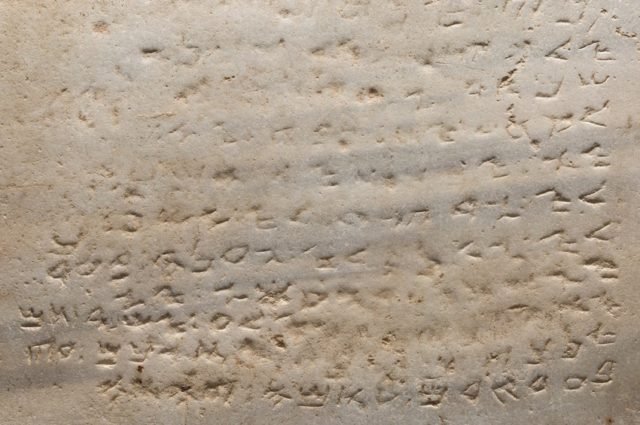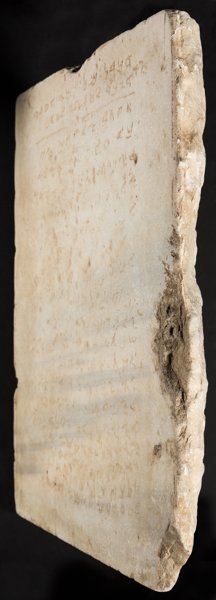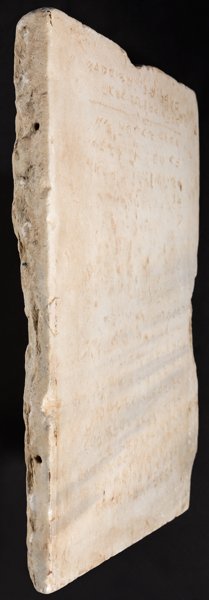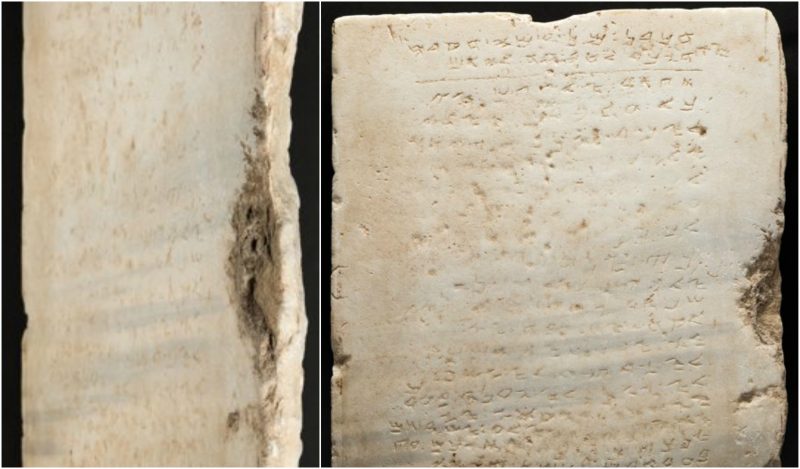An old stone tablet containing one of the earliest inscriptions of the Ten Commandments will go on sale November 16, 2016.
The auction will be held at Heritage Auctions, Beverly Hills.
The tablet, which is also known as The Yavneh Ten Commandments Stone, is currently under the ownership of The Living Torah Museum, Brooklyn, New York.
The Yavneh Stone is a square-shaped white marble tablet, 25 by 22.5 inches and weighing 115 lbs.
The inscription on the tablet contains 20 lines of Paleo-Hebrew characters written in the Samaritan dialect.
The letters and punctuations used in the text are typical for the Samaritan inscriptions made between the fourth and eighth centuries AD.

The Paleo-Hebrew script was a version of ancient Phoenician. It was used from the 10th century BC until the 5th century BC when it was slowly replaced by the Aramaic script.
Although it was overtaken by Aramaic, the Samaritans continued to use their version of Paleo-Hebrew, which is still in use today.
There are two theories about the age of the Yavneh Stone Decalogue inscription; according to Samaritan scholar John Bowman, it dates from the early Islamic occupation period (around 640-830 CE), before the anti-Samaritan massacres under the Abbasid Caliphate.
Other researchers believe that it can be dated further back into the Byzantine era.

The first two lines of the inscription are a dedication. These two opening lines are separated by a line from the rest of the text wich contains the Samaritan version of the Ten Commandments. Here is a line-by-line translation of the tablet written in the Samaritan dialect of Hebrew:
1. Dedicated in the name of Korach
2. I will call you to remember for goodness forever
3. God spoke
4. All these words
5. Saying I am the Lord
6. Your God, you shall not have
7. For yourself other Gods
8. Besides me; you shall not make
9. For yourself a sculptured image or any likeness;
10. For I the Lord
11. Your God am an impassioned God;
12. Remember the Sabbath day
13. Keep it holy; honor
14. Your father and your mother;
15. You shall not murder; you shall not commit adultery;
16. You shall not steal; you shall not bear [false witness] against your neighbor
17. You shall not covet; you shall erect
18. These stones that
19. I am commanding you today
20. On Mount Gerizim rise up to God
It is noticeable that this version is slightly different from the one known today. The “Do not take the name of the Lord in vain” commandment is missing on this list; instead, there is a different one added at the end; it speaks about building a temple on Mount Gerizim (the holy mountain of the Samaritans). That temple is probably the one now located near the West Bank city of Nablus.

The actual origin of the tablets has never been proven.
According to the initial research done in the 1940s, it was unearthed in 1913 by construction workers while building a railroad near Yavneh (a historic city that goes by the Jabneel in the Hebrew Bible), on the southern coast of Palestine.
The workers then sold it to a wealthy local man who decided to lay it on the floor of the doorway of his courtyard.
During the years, the middle part of the inscription was worn away by people stepping on it. Luckily, it can still be read by the use of oblique lights.
Some 30 years later, in 1943, the son of the original owner decided to sell the stone to Mr. Kaplan, a scholar who recognized the Samaritan Decalogue and its real value.
Kaplan invited another scholar to help him with deciphering the stone: Yitzhak Ben-Zvi – an expert in Samaritan history, who later became the second President of Israel.
Ben-Zvi did the majority of research on the Yavneh Stone, and it was later proven that almost his conclusions were right.
The exact date of origin of the stone inscription is still disputed, but besides that, the tablet is a genuine early example of a Samaritan decalogue.
During the 1990s, the tablet was sold to the well-known Israeli antiquities dealer Robert Deutsch, and in 2005 it was acquired by Rabbi Saul Deutsch, the head of the Living Torah Museum.
The Israel Antiquities Authority issued a special permit and special conditions for the export of this artifact. The export of the tablet was allowed only if it was publicly displayed and visible for all. This condition remains for the future owners of the Yavneh Stone too.

The Living Torah Museum stated the following for the upcoming auction:
“The museum, which contains a large collection of artifacts of Jewish life and history dating back to antiquity, is shifting toward a more hands-on focus to attract younger visitors and decided it was time to sell the artifact. The sale will provide us with the money to do what we need to do. It’s all for the best,” Deutsch said in a statement.”
The current online bid for the Yavneh Ten Commandments Stone is $210,000, and it is expected to go higher on the day of the auction.
